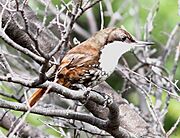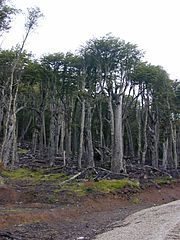White-throated treerunner facts for kids
Quick facts for kids White-throated treerunner |
|
|---|---|
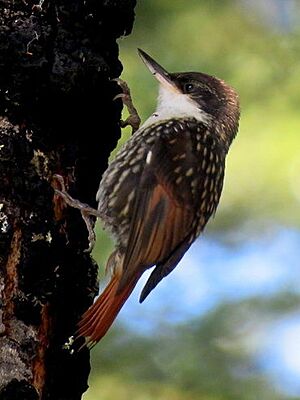 |
|
| Conservation status | |
| Scientific classification | |
| Genus: |
Pygarrhichas
|
| Species: |
albogularis
|
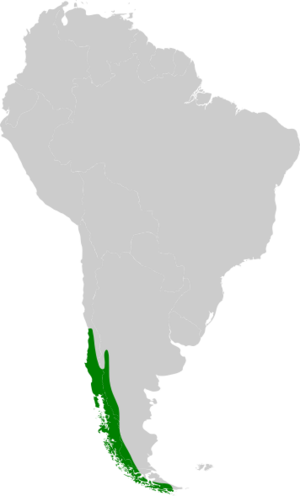 |
|
| White-throated treerunner range | |
The white-throated treerunner (Pygarrhichas albogularis) is a special bird that belongs to the Furnariidae family. It's the only species in its group, called Pygarrhichas. This bird is about 15 centimeters (6 inches) long and has a stiff, rounded tail.
Its top parts are dark brown, turning reddish on its lower back and tail. This color really stands out against its bright white throat and chest. The rest of its belly is spotted with white. The treerunner has a long beak that curves slightly upwards. It looks a bit like a nuthatch bird, even though they are not closely related. Just like nuthatches, the white-throated treerunner constantly searches the trunks and branches of old trees for small insects to eat. It often spirals up tree trunks or even moves head-down! It finds small bugs hiding in the tree bark and makes its nest in holes in trees. When it's not nesting, it might join groups of other bird species to find food.
You can find the white-throated treerunner at the southern tip of South America, in Chile and Argentina. It lives in forests with big, old trees because these trees offer good places to nest. It doesn't matter if the forests are lowlands or highlands, dense or open. This bird was first described in 1831 by Phillip Parker King, a British explorer. Scientists believe its similarities to other bark-eating birds are due to convergent evolution, meaning they developed similar traits independently. The good news is that this bird lives in a large area, and its numbers seem stable. Because of this, the International Union for Conservation of Nature says it's a bird of "least concern", which means it's not currently in danger.
Contents
About the White-throated Treerunner
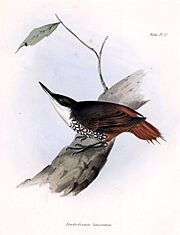
The white-throated treerunner was first described by scientists in 1831. A British explorer named Phillip Parker King gave it the name Dendrocolaptes albogularis. The second part of its name, albogularis, means "white-throated" in Latin.
Later, in 1837, a zoologist named Hermann Burmeister moved the bird to its own group, Pygarrhichas. He chose this name from ancient Greek words meaning "rump" and "wicker," referring to the bird's stiff tail that helps it climb trees.
In 1839, another English bird expert, John Gould, also described the bird, but he didn't know about King's earlier work. He called it Dendrodramus leucosternus, which means "white-bellied." Gould noticed that this bird acted a lot like the Eurasian treecreeper. Over time, scientists have learned more about where this bird fits in the bird family tree.
How Scientists Study Bird Families
Scientists use many clues to figure out how different bird species are related. For a long time, they thought the white-throated treerunner was closely related to other birds that also find food on tree bark. However, looking at their feathers and where they live suggested this might not be true.
Today, scientists use molecular phylogenetics, which means they study the birds' DNA. By looking at their DNA, they can see how closely different species are related. Recent DNA studies show that the white-throated treerunner is related to birds in the Microxenops and Ochetorhynchus groups. This helps scientists understand the bird's family history better.
What the White-throated Treerunner Looks Like
The white-throated treerunner is usually 15 to 16 centimeters (6 inches) long. It weighs between 20 and 27 grams (about 0.7 to 1 ounce). It has dark brown eyes. Its beak is long, about 16 to 24 millimeters (0.6 to 0.9 inches), and curves slightly upwards. The top part of its beak is dark gray, and the bottom part is a pale whitish-gray. Its feet are dark gray, blackish, or brown.
This bird is easy to spot because of its white throat, which stands out against its darker upper body. Its face is brownish-black, and the top of its head is a dull brown. Its back is a lighter chestnut-brown, which turns red on its rump and tail. The feathers on its wings are dark brown, with red or chestnut-brown edges. The main flight feathers are darker, with light edges. Its tail is rounded and has stiff feathers that end in small spines, up to 9 millimeters (0.35 inches) long. These spines help the bird grip tree trunks.
A large white area covers the bird's cheeks and throat, going down to the middle of its chest. The rest of its belly, down to its undertail, has white feathers with dark brown borders. This gives it a spotted look. Male and female adult treerunners look very similar. Young birds, called chicks, have a striped head and back, and sometimes black edges on their throat feathers.
How the White-throated Treerunner Lives
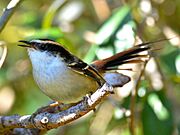
Sounds and Calls
The white-throated treerunner makes a short, sharp sound that might remind you of water drops falling quickly. Its call to other birds is a loud, fast, metallic "kik-ik," "tsi-ik," or "tsik," which it repeats quickly. It can also make a clear "peet peet" sound, and when it flies, it makes a dry "tic."
What the Treerunner Eats
Like nuthatches, the white-throated treerunner is a very active bird. It moves in quick, jerky ways and changes direction fast. It can even climb down tree trunks headfirst! It searches the trunks and big branches of old trees, often spiraling around them. It looks for small insects and their larvae in every crack and crevice. Sometimes, it taps lightly with its beak, like a woodpecker, or digs out larvae from under the bark. It uses its tail to help it balance while climbing.
We don't know a lot about its exact diet, but it eats small bugs, including adult beetles and their larvae, as well as flies. A study found that the white-throated treerunner mostly looks for food on trees like Coigüe (Nothofagus dombeyi) and Neuquén Roble (N. obliqua). It especially likes dead trees, even if other types of trees are around. This might be because of the bark's texture or because there are more bugs hiding there. In some places, like islands without predators on the ground, it might also find food on the ground.
When it's not breeding season, the white-throated treerunner might join groups of other birds to find food. These groups can include the thorn-tailed rayadito (Aphrastura spinicauda), the striped woodpecker (Veniliornis lignarius), and sometimes even the fire-eyed diucon (Xolmis pyrope), Patagonian sierra finch (Phrygilus patagonicus), and the black-chinned siskin (Spinus barbatus).
Reproduction and Nests
The white-throated treerunner builds its nest in holes in trees. It might use holes in old or fire-damaged trees. Since it's not as good at making its own holes as woodpeckers are, it often reuses holes that are already there. Sometimes, woodpeckers act aggressively towards other birds that try to use their holes, suggesting they compete for nesting spots. However, the white-throated treerunner is happy to use nest boxes that people put up.
The nest hole is usually between 3 and 8 meters (10 to 26 feet) above the ground. The hole itself is about 25 to 40 centimeters (10 to 16 inches) deep. The nest doesn't have much lining, just wood chips from the hole. But sometimes, people have seen nests with grass and feathers. The breeding season probably happens during the southern spring and summer. Eggs are usually laid in November or December, and the young birds hatch in December.
Scientists believe that white-throated treerunners are monogamous, meaning they stay with one partner. They usually lay two to three eggs. Eggs that have been studied were about 21.5 to 22 millimeters long and 16.7 to 17 millimeters wide. Scientists have learned that these birds can live for at least 3 years and 8 months.
Where the Treerunner Lives
This bird lives in central and southern Chile and western Argentina. You can find it from Santiago and Mendoza all the way down to Tierra del Fuego. It even lives in the southernmost forest in the world, on Horn Island. It can live from sea level up to 1,200 meters (about 3,900 feet) high.
The white-throated treerunner likes forests with big, old trees, whether they are dense or more open. It avoids young forests. It especially likes forests with "false beech" trees from the Nothofagus group. It climbs on the trunks from the middle of the tree all the way to the top, just like a small woodpecker would. This bird usually stays in one area, but it might move around more when it's not breeding season.
The Treerunner and People
In Local Stories
The white-throated treerunner appears in some old stories from the Yagan people, who call it tatajurj. In these stories, it helps women collect special mushrooms called Cyttaria (or katran in Yagan) from the trunks of Magellanic Beech, Lenga, and Ñire trees.
Protecting the Treerunner
The white-throated treerunner needs old, dying trees to nest in. These specific habitats are becoming rarer, so they need to be protected. However, this bird is quite common and lives in many protected areas. These include Vicente Pérez Rosales National Park, Puyehue National Park, Nahuelbuta National Park, and La Campana National Park in Chile. In Argentina, it lives in Tierra del Fuego National Park.
The area where the white-throated treerunner lives is huge, about 470,000 square kilometers (181,000 square miles). Its numbers are thought to be stable. Because of this, the International Union for Conservation of Nature considers the species to be of "least concern", meaning it's not currently at risk of disappearing.



